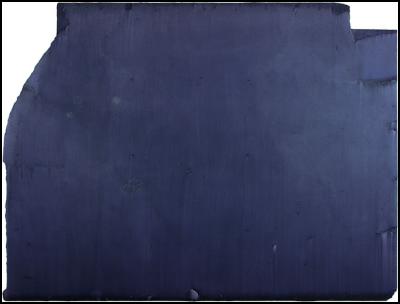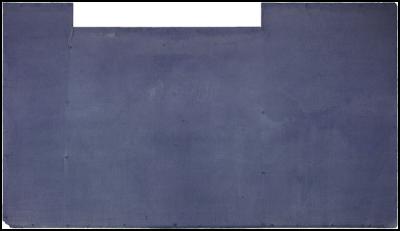Bowerbank Ninow presents Kim Pieters - the mallarmé suite
Bowerbank Ninow presents Kim Pieters - the mallarmé suite: 26 October, 2016
Anthony Byrt characterises Kim Pieters’ work as possessing a feeling of “wintry, subantarctic cool.” This description suggests the chill environs of the artist’s home in Dunedin, but is also representative of a more studied, intellectual coolness: a willingness to engage with ambivalence and to investigate the potentialities of paradox, uncertainty and, above all, chance. In the mallarmé suite, large hardboard panels salvaged from a building site form the basis for delicate fields of colour, their ragged edges and holes speaking of a previous existence as parts of an architectural whole.

nothing will have taken
place but the place, 2013, mixed media on board, 1220 x
1640mm
Pieters is an artist who works primarily in series, creating groupings of works that function together to elaborate on a particular theme, mood or approach. Language plays an important role in this methodology, as does its absence or failure. With the mallarmé suite, Pieters undertakes a meditation on the poet’s most difficult and arguably most important work: Un Coup de Dés Jamais N’Abolira le Hasard, first published in 1897, a year before Mallarmé’s death in 1898. This poem—in English, A Throw of the Dice Will Never Abolish Chance—describes the conflict between being and nothingness, as it relates to art’s ability to engage with the universe. Mallarmé’s poem describes the plight of a mariner-artist, the “Master,” rolling dice in the midst of a “shipwreck on the shoals of meaninglessness or contingency,” in the words of Henry Weinfield’s commentary. More generally, Weinfield sees the poem as addressing the problem of “how to establish meaning in an essentially meaningless universe,” a dilemma towards which Pieters, by invoking Mallarmé, also gestures. Although it is tempting to view these paintings as flotsam and jetsam that has been, at least in part, uncovered or stumbled upon rather than created, the randomness embodied by the found panels themselves is merely a starting point. For Pieters, these found materials serve as “a throw of the dice,” a raw act of chance from which new meanings can be generated. The choices the artist makes, in the face of a phenomenal universe functioning seemingly at random, become her necessity, and become the foundation upon which meaning can be built and understood.

All thought emits a Throw of
the Dice, 2013, mixed media on board, 1000 x
1750mm
One of the more radical departures from nineteenth-century lyric practice in Un Coup de Dés is its form. The poem’s individual lines and phrases are unevenly dispersed over double-page spreads, which are intended to be read from left to right across the two leaves. Because of this unorthodox typesetting, the white of the paper itself assumes a vital role in organising and framing the reader’s response to the poem. Although, as Mallarmé himself notes in his preface, “versification always demanded them as a surrounding silence,” the way Un Coup de Désdeploys these empty spaces constitutes a radical emphasis on the physicality of the page itself. Pieters is likewise concerned with physicality and presence in her work, citing Yoshihara Jiro’s Gutai Art Manifesto, which speaks of the beauty of art and architecture that has succumbed to decay and entropy: “it may be that the innate beauty of matter is reemerging from behind the mask of artificial embellishment. Ruins unexpectedly welcome us with warmth and friendliness.” The paintings of the mallarmé suite are beautiful in this way: they speak of that which is abandoned, of the interstitial spaces of the city where the remains of physical culture pile up and are forgotten. Ignaci de Solà-Morales defines these spaces as the “terrain vague,” the empty or unproductive zones existing within the urban environment that constitute a kind of counter-city. However, these paintings are not themselves unproductive; they are working to reclaim the terrain vague, to allow the viewer to navigate these spaces in a way that is productive of meaning.

were it to exist, were it to
begin, 2013, mixed media on board, 750 x
920mm
Although Pieters cites Mallarmé through the titles of her works, her paintings advance a position that does not necessarily align with that of the poet himself. In an interview with Hamish Clayton, Pieters suggests that Mallarmé “did a sorrowful thing in opposing chance and necessity” in Un Coup de Dés. Rather than adopting an oppositional approach, Pieters’ works “fuse the two” concepts, making “chance and necessity work together.” Unlike Mallarmé, who laments the loss of a higher order (such as God or Fate) that would ascribe meaning to the events of the phenomenal universe (the rolling dice), Pieters deals with the world as it is, creating ideas and meanings that can coexist with chance itself. These paintings are not a lament for an ordered universe that no longer exists (and perhaps never existed), but neither are they an affirmation of the supremacy of chaos. They are a negotiation, an act that seeks to transform the materials of raw chance into something useful to the world. Pieters is, in some sense, a pragmatist.
This negotiation between chance and necessity, between randomness and meaning, is consequential not only for the artist herself, but also for the viewer of these works. According to Pieters, “the viewer is confronted with a throw of a dice. The meaning any one person may make of it is the result of their choices, is contingent on what is necessary for them at any one time.” Pieters’ inquiry, into the relationship between that which is the product of chance and that which is the product of necessity, is not limited to a dialogue between the artist and the universe: it includes us too, and the possibilities and options that are open to us.


 National Youth Theatre: 140 Christchurch Kids Shine In National Youth Theatre’s Historic CATS Premiere
National Youth Theatre: 140 Christchurch Kids Shine In National Youth Theatre’s Historic CATS Premiere NZ Symphony Orchestra: NZSO To Tour Masterworks By Mozart, Beethoven, Haydn And More
NZ Symphony Orchestra: NZSO To Tour Masterworks By Mozart, Beethoven, Haydn And More Journal Of Public Health: Vape Shops Cluster Around Schools
Journal Of Public Health: Vape Shops Cluster Around Schools Timaru District Council: Aigantighe Art Gallery Hosts An Iconic Robin White Touring Exhibition
Timaru District Council: Aigantighe Art Gallery Hosts An Iconic Robin White Touring Exhibition Victoria University of Wellington: Dame Winnie Laban Awarded Honorary Doctorate Recognising Achievements For Pasifika
Victoria University of Wellington: Dame Winnie Laban Awarded Honorary Doctorate Recognising Achievements For Pasifika  HESSA: This Isn’t Fair—And It’s Time To Fix It - HESSA Petition Calls For Inclusive Student Sports
HESSA: This Isn’t Fair—And It’s Time To Fix It - HESSA Petition Calls For Inclusive Student Sports